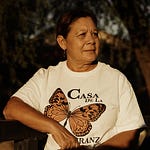This month The Border Chronicle is focusing on a series on the climate crisis, displacement, and borders, and today’s podcast is a continuation of that. I am happy to be joined by insightful researcher Nathan Akehurst and by Petra Molnar, an anthropologist, lawyer, and top expert on border technology. Petra is also the associate director of the Refugee Law Lab, and she helps run the Migration Tech Monitor.
Our discussion looks at the border, the border-industrial complex, and all the technologies in development (like robotic dogs) in the face of the intensifying climate crisis. Petra draws from the extensive research she has done for her forthcoming book, Artificial Borders: AI, Surveillance, and Border Tech Experiments, and Nathan brings analysis from the paper “Border Violence and Security in a Warming World,” for which he was the principal author (I was a coauthor, and we are publishing the paper below).
In today’s discussion, we identify climate displacement and increasing border enforcement as two growing trends. But Petra and Nathan also begin to imagine different ways out of the crisis. In many ways this continues a compelling discussion we had last week with several experts and readers on this very subject.

Border Violence and Security in a Warming World
By Nathan Akehurst with Mark Akkerman, Nick Buxton, and Todd Miller
In the mid-2000s, a security corporation ran an advert claiming that their thermal imaging technology would “have your back in Baghdad or Baton Rouge”, illustrated with an Army gunship and police helicopter. Geographer Stephen Graham references the image in a comprehensive analysis of how the US’ overseas wars of the early 2000s fostered simultaneous domestic and international securitization.1 New military technologies were developed in war, sold as battle-tested to other states, used to project force through military and border expansion, and deployed at home against suspect populations in the context of state-driven domestic security paranoia. This nexus is fundamental to the contemporary development of borders in the US and beyond. It has also provided the US, and more broadly the Global North, with a set of pre-existing strategies to pursue against new threats; and disincentivized considering alternatives.
Deepak Bhargava’s “Statue of Liberty” plan, which this paper responds to, is a bold vision to reset migration policy and reform borders. Attempts at structural border reform first necessitate clearly understanding what borders are, and which actors determine them. Borders are broadly understood as linear geographical divisions bounded by entry and exit checks and a system of diminished rights and entitlements for non-citizens in a territory. Yet today, the Global North’s borders arrange life deep inside and outside the countries they supposedly guard and comprise multiple complex systems driven by state and private actors which track or stop movement and make migrants expendable or exploitable. These can be roughly grouped into:
· Infrastructure to prevent and control movement by force; in which traditional technologies such as barbed wire and weaponry have been augmented by innovations like “smart walls”2, autonomous detection and monitoring systems (including drones) and sound cannons3.
· Expanded powers and funding for militarized police and border forces including programs to enforce border controls in everyday settings like communities and workplaces, vast networks of detention jails4, and deportation infrastructure.
· Lawfare; including the denial of legal support and basic rights to asylum seekers and the criminalization of everyday citizens – from those who rescue migrants to demands that doctors check the migration status of their patients5.
· Surveillance, data extraction, and biometric technologies deployed not only at borders but often against the general population with the apparent aim of migrant surveillance.
· International structures and alliances that outsource border management and infrastructure to third countries, helping to drive down human rights standards, such as the US-Mexico Merida Initiative (renamed the Bicentennial Framework in 2021.6
The scale and scope of the new border is vast and evolving. As states begin reacting to climate impacts, the border has formed part of their arsenal with which to do so. A stark example of this is the widely documented horsewhipping of Haitians in Texas , many fleeing extreme weather.7 Climate impacts8 in the ‘dry’ zone of Central America are currently largely driving internal displacement, but has also led to more international migration.9 The current and potential impact of climate change on already fragile political conditions will rarely be easy to track or measure. Given the lack of available resources for supporting countries to adapt to climate change, militarized borders is often the default response to climate-linked displacement.10

Border expansion as the basis of a hostile response to climate-linked movement is an extension of the border’s already expansive role in public life. It aims to deter migrants through brutality; a strategy that does not work11, but does increase lethality and raise the question; how much death are policymakers comfortable with?
It structures politics around fear of outsiders; both feeding that fear and acting as proof of political action, whilst embedding a national security narrative at the heart of all policy. It blocks movement that governments do not desire while speeding up movement that they do, from “smart” VIP lanes to US border posts at trade ports across the world - which is already all but borderless for extractive industry. It provides a testbed for breaches of human rights against vulnerable people. It forms part of an increasingly complex game of bargaining between states, dominated by the Global North’s border drive. Moreover, the global border apparatus provides growing and lucrative markets, as well as a forum for exchanging ideas, between states and the arms, technology, logistics, consultancy and other industries. This is a nexus of institutions that receives information about the world and processes it in terms of foreign threats that require constantly upgraded “defenses,” that now includes walls, armed agents, and incessant surveillance. In a climate context, such thinking is particularly deadly.
The “military-industrial complex” term coined by Eisenhower in the 1960s has been recently bolstered by a plethora of related terms familiar in activist movements; the “prison-industrial complex”, “border-industrial complex”, and so on. They describe the shared nest of state, commercial, and political interests around perpetuating a destructive phenomenon. The distinction between these “complexes” is blurring, as Global North strategic thinking moves towards understanding threats as overlapping and linked, and as the industry diversifies across markets. The UK’s Integrated Review12 of defense, security and foreign policy and the EU’s Strategic Compass proposal13 join US thinking in attempting to provide an integrated response to multiple phenomena framed as security challenges – as well as understanding climate change and its consequences, including migration as a primary security threat. Recent scholarship on weaponized interdependence14 details changes in how powerful countries exploit their position in global networks from banking to arms manufacturing to pursue hybrid interstate conflict. In terms of how this is operationalized, former Pentagon analyst Rosa Brooks provides a powerful account15 of how the military, defense industry, and securitarian thinking has spread into domains from aid to policing, to entertainment, and to economics. “Climate action” after a fashion is coming; albeit one that understands both climate and migration as two more factors in the battlespace.
The commercial dimension is fundamental to this. The border and surveillance industry (BSI), the migration-linked subset of the broader militarized ecosystem, thrives and profits from demand for security technology and was worth $68bn as of 202116. But it is much more than a passive provider of services. It devises, innovates, and aggressively sells new systems – such as Amazon’s imbrication in ICE digital infrastructure. Like the arms industry; it lobbies hard for the deployment of its technologies. Corporate Europe Observatory17 has outlined the expansive lobbying operation involved in EU border agency Frontex’s €6bn budget hike. In general, policy makers in the Global North tend to embrace BSI lobbyists as ‘experts’ on issues such as migration and the (consequences of) climate change instead of salesmen primarily serving the interests of their companies.
The BSI spans a wide range of sectors; most obviously arms and surveillance, but also biometrics, logistics, academia, and public relations in a way that creates arguments for securitization in the face of future threats and then fulfills that demand. This corporate involvement also increases the scale of abuse as a product of the rush to innovate. In one recent US example, a deportation flight provider used torture devices to restrain deportees18. In another, a Peter Thiel-funded startup cheerily pitched drones to tase migrants in the desert19. Furthermore, the linkage with other industries increases profitability; many of the same companies involved in weapons that displace people in armed conflicts, for instance, are also involved in tracking and blocking those people once displaced.20
Climate is again central to the profiteering question. The border, surveillance and security industries firstly, as hinted at above, engage in the presentation of false “solutions” to climate change such as ramping up border control. In doing so, they create a false sense of security and provide alternative routes of action for states to take other than decarbonization. The biggest investors in what has been dubbed the “Global Climate Wall”21 are also the biggest polluters, and their border spending dwarfs their spending on climate finance for the world’s poorest countries. Most projected climate-linked migration is within the global south, but will also be adversely affected by border control becoming a dominant form of “adaptation.”
The Global North wants to keep migrants as far away as possible.
The growing number of incidents in which violence against migrants is justified by claims of third countries “weaponizing” migration flows also needs consideration here. Its logic goes: because migrants are used by countries such as Turkey, Belarus, and Morocco to undermine Western states, a violent response is justified and human beings should be reduced to the status of projectiles to be intercepted. Underpinning this, of course, is the idea that peripheral countries should police migration on behalf of the core. In the context of climate-linked displacement, this can only intensify. The private sector again has a huge hand here – BSI firms continued to train, for instance, Saudi border forces even after reports of them shooting at migrants22. Finally, the industry has a revolving door with fossil fuel firms, and firms linked to it also routinely provide services to suppress those resisting extractive industries and land grabs – in turn, fueling both climate change and displacement.
The global border is vast, and its constituent parts learn from each other across countries. The same actors are involved in administering violence at US, EU, UK, and Australian borders and while they are currently chiefly engaged in Global North borders, there are growing concerns that this logic will influence many more countries. There is political unity compounding geographical unity. An obvious confluence of interests exists on the hard right, encapsulated neatly by Thiel Capital’s appointment of former Austrian chancellor Sebastian Kurz. But the more liberal EU is also overseeing large scale border expansion. Even where the Biden administration claims to be “ending for profit detention”, the small print is that migrants will continue to be tracked and criminalized using advanced technologies which will enrich BSI contractors. In fact, without inflammatory hard-right rhetoric on migration, similar immigration policy may face far less scrutiny from moderates.
All this presents challenges for immigration reformers. Bhargava’s “Statue of Liberty plan”23 is a bold attempt to develop a coherent progressive agenda. It is broadly characterized by a desire to unlock the best of national traditions, build a functioning social majority and find a viable social democratic policy goal. Similar big-picture proposals exist in Europe24. This is not a question of one country changing policies, or even a competition to be the ‘most welcoming’ one, but the understanding that this requires change on a global scale and to more than just migration policy. We need to challenge the extractive and inequitable economic system that sees both people and planet as means for the profit of the few.
In this context of border expansion and the border complex, headline demands must be undergirded by a policy and narrative strategy to expose and undermine the web of actors engaged in border violence. In periods of uncertainty the nationalist narrative is compelling. Pandemic surveillance has increased the penetration of border control and surveillance, and deepened our collective sense of risk, whilst activating nationalist thinking (for instance, vaccine-hoarding.) The climate threat cannot be allowed to go the same way.
The pro-borders coalition consists of disparate actors linked by common interest. Reformers must do the same; the links developed above are an urgent case for climate movement actors and other parts of civil society to embed migration justice in their work. That work should include relentless pressure – political, economic, and movement-based - on border violence profiteers. The industry generally prefers to work in the shadows, and the usual toxic migration debate can be disrupted by pointing to the firms profiting from human misery atpublic expense. They are a compelling – and real – alternative villain in a discourse dominated by those villainizing people seeking safety. Furthermore, it must be spelled out that the border and its sponsors are not only bad for migrants. The byproducts include climate inaction, geopolitical crises, routine repression of humanitarians, and extended mass surveillance. We need a clear explanation of who wins and who loses under a policy of private-public border expansion.
Underpinning this should be an alternative providing real security and safety for all. Border demilitarization is the first step; divesting from the BSI, dismantling the violent infrastructure, restoring human rights and the rule of law at borders, closing the detention complex and spying machine, and reinvesting the resources saved in making migration work. Meanwhile, as Bhargava's paper makes clear; in an age of climate-induced migration, “also essential are policies that redress the ill effects of U.S. foreign and economic policy in driving migration...and measures to address the root causes of poverty to make the “right not to migrate” real.” We need to support people wishing to stay in their homes through safeguarding environments and support countries to administer short-term, temporary, and internal migration and provide safe routes to the global north. The International Committee of the Red Cross reports that they are already dealing with climate impacts in all 192 countries where they work25. In an era of real and rising climate threats to human life and livelihoods from habitability to food security - most acutely among vulnerable populations but ultimately among all of us – we simply do not have time to expend on fictional threats.
Above all we need a step change in how we see migration. Even some progressives still view it as a problem to be managed. But migration is a fact of life and has always brought great benefits for both travelers and hosts, especially when societies facilitate it well. Bhargava’s paper makes a powerful broad argument for the immense value of migration. In a warming world there is a more specific one; migration is a form of human resilience and adaptation, and people moving will bring with them skills and knowledge needed to preserve environments and protect life. (Migrant workers currently bear the brunt of fixing climate disasters in the US as an exploited group of workers; instead we need stronger labor protections across the board.) We cannot afford the ongoing “us and them” presentation of migrants and migration. Let the division instead be between the few that manipulate social and economic fears to profit from human suffering and the building of a more physically and politically divided planet unable to address its common challenges, and the rest of us; all those who want to live safe and flourishing lives in a just and habitable world.
Graham, 2010, The New Military Urbanism https://www.versobooks.com/books/365-cities-under-siege
Transnational Institute, 2021 https://www.tni.org/en/publication/smart-borders-or-a-humane-world
Coda Story, 2021 https://www.codastory.com/authoritarian-tech/sound-cannons-greece/
Global Detention Project, 2022 https://www.globaldetentionproject.org
Docs Not Cops, 2022 http://www.docsnotcops.co.uk/about/
Gobjerno de Mexico, 2021 https://www.gob.mx/sre/prensa/mexico-and-united-states-begin-work-on-bicentennial-framework?idiom=en
https://www.bbc.com/news/world-us-canada-58654351
https://www.newyorker.com/news/dispatch/how-climate-change-is-fuelling-the-us-border-crisis
NBC, 2021 https://www.google.com/url q=https://www.nbcnews.com/politics/immigration/trump-admin-ignored-its-own-evidence-climate-ch ange-s-impact-n1056381&sa=D&source=docs&ust=1644969780232469&usg=AOvVaw2QxC-OsY-LPWrVA7p1HgRo
DHS 2013 https://www.dhs.gov/sites/default/files/publications/DHS%20Climate%20Action%20Plan.pdf
New Humanitarian, 2017 https://deeply.thenewhumanitarian.org/refugees/community/2017/06/13/border-walls-dont-stop-immigration-but-they-do-underm ine-integration
UK Government, 2021 https://www.gov.uk/government/publications/global-britain-in-a-competitive-age-the-integrated-review-of-security-defence-devel opment-and-foreign-policy
ECAS, 2021 https://eeas.europa.eu/headquarters/headquarters-homepage/106337/towards-strategic-compass_en
Newman 2021 https://direct.mit.edu/isec/article-abstract/44/1/42/12237/Weaponized-Interdependence-How-Global-Economic?redirectedFrom= fulltext
Brooks, 2016 https://ndupress.ndu.edu/Publications/Article/1326012/how-everything-became-war-and-the-military-became-everything-tales-fr om-the-pen/
Vice, 2021 https://www.vice.com/en/article/k7873m/how-the-dollar68-billion-border-surveillance-industrial-complex-affects-us-all 17 No Tech for ICE, 2022 https://notechforice.com/
Corporate Europe Observatory, 2021 https://corporateeurope.org/en/lobbying-fortress-europe
San Diego Union Tribune, 2021 https://www.sandiegouniontribune.com/news/immigration/story/2021-10-13/ice-torture-asylum-seeker-deportation
The Intercept, 2021 https://theintercept.com/2021/12/13/brinc-startup-taser-drones-migrants/ 21 Transnational Institute, 2021 https://www.tni.org/en/publication/smoking-guns
Transnational Institute, 2021 https://www.tni.org/en/publication/global-climate-wall
Ibid.
Transnational Institute, 2021 https://www.tni.org/en/financingborderwars
Bhargava, 2021 https://newlaborforum.cuny.edu/2021/08/26/social-democracy-or-fortress-democracy-a-twenty-first-century-immigration-plan/ 25 Renewal, 2020 https://renewal.org.uk/wp-content/uploads/2020/09/renewal27.4_03akehurst-1.pdf
Red Cross, 2021 https://www.ifrc.org/sites/default/files/2021-10/IFRC-Displacement-Climate-Report-2021_1.pdf
New Yorker, 2021 https://www.newyorker.com/magazine/2021/11/08/the-migrant-workers-who-follow-climate-disasters














Share this post